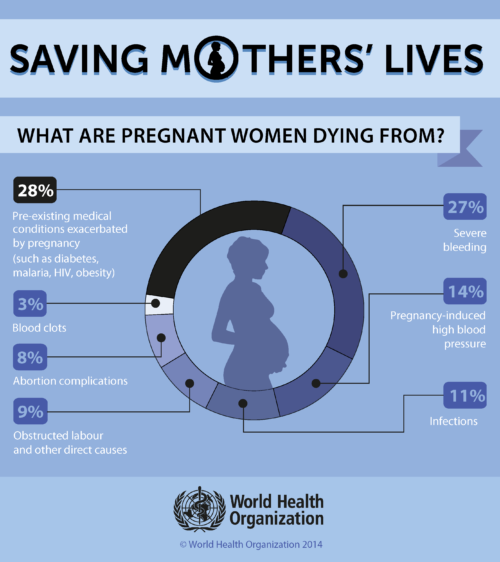By: Zoreed Mukhtar
2019—2020 Global Health Policy Coordinator & Health Care for All Steering Committee Member

When you hear of maternal mortality, you may think that it is a foreign concept that only occurs in parts of Asia or Africa. The harsh reality is that in the developed world, the United States has the worst maternal death rate and is the only country where the maternal mortality rate has increased, doubling over the past two decades. Maternal mortality refers to deaths due to complications from childbirth or pregnancy. The most common complications include severe bleeding, infections, high blood pressure, unsafe abortions, drug overdose, and complications from delivery. The good news is that most of these complications are preventable or treatable. In fact, in the United States, 60% of maternal deaths are preventable. For example, injecting Oxytocin after childbirth effectively reduces the risk of bleeding. Practicing good hygiene and recognizing/treating early signs can lower the risk of infection. Administering drugs such as magnesium sulfate for pre-eclampsia can reduce the risk of developing eclampsia. Lastly, it is important that women have access to contraception and safe abortion services as well as quality post-abortion care in order to prevent unwanted pregnancies and avoid maternal deaths.
Unfortunately, health care disparities that exist globally make it difficult for women in other countries to have equal access to care. It is also important to consider intersectionality when trying to lower maternal mortality rates. For example, according to UNICEF, maternal mortality rates are 2-4 times higher among African-American women than among white women. Also, sub-Saharan Africa and South Asia account for 87% of maternal deaths. Specifically, sub-Saharan Africa has the highest maternal mortality ratio of 68% of all maternal deaths worldwide, while South Asia follows with a maternal mortality ratio of 19%. Globally, the maternal death ratio has declined by 35% from 2000 to 2017, according to the United Nations (UN). However, over 800 women are still dying each day from pregnancy and childbirth related complications and for every woman who dies, approximately 20 other women suffer from infections, disabilities, or injuries. Several factors can prevent women from receiving or seeking care during pregnancy or childbirth such as poverty, racism, distance to healthcare facilities, lack of information, inadequate services, and cultural practices. In order to improve maternal health, barriers that limit access to quality health services must be identified and addressed.
Currently, there is a bill on the house and senate floor, titled the Reach Every Mother and Child Act (S.1776, H.R.4022). This bill was introduced by Susan Collins (R-ME) in the senate and by Dave Reichert (R-WA) in the house. It is currently co-sponsored by 15 democrats and 14 republicans in the senate including Elizabeth Warren and Mario Rubio, as well as 143 democrats and 69 republicans in the house including Joaquin Castro, Joe Kennedy, and Pramila Jayapal. This bi-partisan legislation aims to implement policies and provide foreign assistance in order to end preventable newborn, child, and maternal deaths globally. This bill would commit the U.S. government to coordinating and scaling healthcare solutions such as routine immunizations and breastfeeding. Specifically, improving breastfeeding practices could help save the lives of more than 800,000 children globally. The Reach Every Mother and Child Act would require a coordinated U.S. government strategy, establish rigorous reporting requirements, and ensure that the U.S. Agency for International Development creates the most effective programs.
Are you ready to take action? Call-in or email your legislators and ask them to co-sponsor the Reach Every Mother and Child Act.
Find your U.S. House representative’s contact information:
https://www.house.gov/representatives
Find your U.S. Senate representatives’ contact information:
https://www.senate.gov/general/contact_information/senators_cfm.cfm
For more information: https://savethechildrenactionnetwork.org/reach/
Join me in helping to get this bill passed. The lives of mothers and children around the world depend on it.
References
Centers for Disease Control and Prevention. (2019, September 4). Maternal mortality. Retrieved November 19, 2019, from https://www.cdc.gov/reproductivehealth/maternal-mortality/ index.html.
Hollier, L. (2019, March 19). The painful truth about maternal deaths. Retrieved November 19, 2019, from https://www.aamc.org/news-insights/insights/painful-truth-about-maternal-deaths.
Nina, M., & Montagne, R. (2017, May 12). The last person you’d expect to die in childbirth. Retrieved November 19, 2019, from https://www.npr.org/2017/05/12/527806002/focus-on-infants-during-childbirth-leaves-u-s-moms-in-danger.
Roser, M., & Ritchie, H. (2013, November 12). Maternal mortality. Retrieved November 19, 2019, from https://ourworldindata.org/maternal-mortality.
Save the Children. (n.d.). Reach every mother and child act. Retrieved November 19, 2019, from https://www.savethechildrenactionnetwork.org/articles/reach-factsheet/.
Shah, N. (2018, October 16). A soaring maternal mortality rate: what does it mean for you? Retrieved November 19, 2019, from https://www.health.harvard.edu/blog/a-soaring-maternal-mortality-rate-what-does-it-mean-for-you-2018101614914.
UNICEF. (2019, September). Maternal mortality. Retrieved November 19, 2019, from https://data.unicef.org/topic/maternal-health/maternal-mortality/.
World Health Organization. (2019, September 19). Maternal mortality. Retrieved November 19, 2019, from https://www.who.int/news-room/fact-sheets/detail/maternal-mortality.

